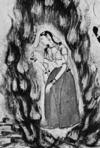- Sita
-
/see"tah/, n.
* * *
She sprang from a furrow when King Janaka was plowing his field, and Rama won her as his bride by bending Shiva's bow. Her abduction by the demon king Ravana and subsequent rescue are described in the Ramayana. She kept herself chaste during her long imprisonment, and on her return she proved her purity by undergoing an ordeal by fire. A symbol of the sufferings and strengths of women, she is one of the most revered figures in the Hindu pantheon. Sītā, Mughal painting, c. 1600; in the collection of Bharat Kala Bhavan, ...Pramod Chandra
Sītā, Mughal painting, c. 1600; in the collection of Bharat Kala Bhavan, ...Pramod Chandra* * *
▪ Hindu mythologyin Hindu mythology, the consort of Rāma (Rama) and the embodiment of wifely devotion and self-surrender. Her abduction by the demon king Rāvaṇa and subsequent rescue are the central incidents in the great Hindu epic Rāmāyaṇa (“Romance of Rāma”). Sītā was raised by King Janaka; she was not his natural daughter but sprang from a furrow when he was ploughing his field. Rāma won her as his bride by bending Śiva's bow, and she accompanied her husband when he went into exile. Though carried away to Laṅkā by Rāvaṇa, she kept herself chaste by concentrating her heart on Rāma throughout her long imprisonment. On her return she asserted her purity and also proved it by voluntarily undergoing an ordeal by fire. Rāma, however, banished her to the forest in deference to public opinion. There she gave birth to their two children, Kuśa and Lava. After they reached maturity and were acknowledged by Rāma to be his sons, she called upon her mother, Earth, to swallow her up.Sītā is worshiped as the incarnation of Lakṣmī, the consort of Vishnu. She is frequently depicted in Indian miniature paintings of the Rāmāyaṇa, and her images in bronze are among the finest achievements of South Indian (South Indian bronze) art. These usually form a group, with images of Rāma, his brother Lakṣmaṇa, and his devotee, the monkey Hanumān; the iconographic texts instruct the artist to show Sītā looking at her husband with supreme happiness.* * *
Universalium. 2010.
